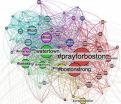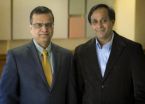(Press-News.org) DURHAM, NH –– In a paper published today in Nature Communications, an international team of scientists, including three from the University of New Hampshire's Space Science Center, uncovers the origin and cause of an extreme space weather event that occurred on July 22, 2012 at the sun and generated the fastest solar wind speed ever recorded directly by a solar wind instrument.
The formation of the rare, powerful storm showed striking, novel features that were detected by a UNH-built instrument on board NASA's twin-satellite Solar TErrestrial RElations Observatory (STEREO) mission. An instrument led by the University of California, Berkeley also made key measurements.
The 2012 storm was so powerful that had it been aimed at Earth instead of at the STEREO A spacecraft, which was located 120 degrees off to the side of Earth, the consequences would have been dramatic: widespread aurora, satellite malfunctions, and potential for failures with ground-based electricity grids.
To date, it has been unclear how extreme space weather storms form and evolve. Developing a better understanding of their causes is vital to protect modern society and its technological infrastructures, and is one of the goals of the STEREO mission.
"These results provide a new view crucial to solar physics and space weather as to how an extreme space weather event can arise from a combination of multiple solar eruptions," says research assistant professor Noé Lugaz of the UNH Institute for the Study of Earth, Oceans, and Space (EOS) and a coauthor on the Nature Communications paper.
Lead author is Ying D. Liu of the State Key Laboratory of Space Weather, National Space Science Center, Chinese Academy of Sciences.
The authors suggest it was the successive, one-two punch of solar eruptions known as coronal mass ejections (CMEs) that was the key to the event, which blasted away from the sun at 3,000 kilometers per second—a speed that would circle the Earth five times in one minute. Detecting the successive eruptions would not have been possible prior to STEREO.
"In a sense, this was the 'perfect storm'," Lugaz says. "The first, fast eruption greased the skids for the quick propagation of the subsequent, extremely fast eruptions through interplanetary space."
CMEs are clouds of magnetic fields and plasma—a hot gas composed of charged particles—and, in the July 2012 event, the in-transit interaction between two closely launched CMEs resulted in the unusually powerful and fast-moving space weather event.
Says EOS research professor Charles Farrugia, coauthor on the paper, "Remarkably, this is reminiscent of the great solar flare in 1859, the Carrington Event, and the geomagnetic storm of unheard of intensity in Earth's magnetosphere, or magnetic field, that occurred less than one day later."
Adds coauthor Antoinette Galvin, EOS research professor and principal investigator on STEREO's PLAsma and Supra-Thermal Ion Composition (PLASTIC) instrument that detected the extremely fast solar wind protons, "STEREO has dramatically improved our understanding of the powerful solar eruptions that can send more than a billion tons of the sun's outer atmosphere hurtling into space."
PLASTIC, together with the University of California, Berkeley-led In-situ Measurements of Particles and CME Transients (IMPACT) instrument, made the critical measurements of the July 2012 solar storm.
The STEREO mission, launched in October 2006, is comprised of two nearly identical spacecraft the size of golf carts. Their observations enable scientists to construct the first-ever three-dimensional views of the sun. PLASTIC provides plasma characteristics of protons, alpha particles and heavy ions. Solar wind protons and alpha particles constitute most of the mass in the solar wind and are therefore the primary components exerting kinetic pressure on the Earth's magnetosphere—one of the drivers for space weather.
INFORMATION:
For more information on the STEREO mission, visit http://stereo.sr.unh.edu.
The STEREO mission is managed by NASA's Goddard Space Flight Center. The Johns Hopkins University Applied Physics Laboratory designed and built the spacecraft.
The University of New Hampshire, founded in 1866, is a world-class public research university with the feel of a New England liberal arts college. A land, sea, and space-grant university, UNH is the state's flagship public institution, enrolling 12,300 undergraduate and 2,200 graduate students.
Image to download: http://stereo.gsfc.nasa.gov/img/stereoimages/print/FASTEST_cme_comboA.tif
Caption: This image combines data from two coronagraphs and an extreme ultra-violet imager (green) on STEREO A. The CME is the bright streaks emanating from the sun. A coronagraph is a telescope that uses a disk to block the sun's bright surface revealing the solar corona. Image courtesy of NASA.
Movie to download: Fastest_cme_20120723a_combo.mov http://stereo.gsfc.nasa.gov/img/stereoimages/movies/Fastest_cme_20120723a_combo.mov
Caption: NASA movie of the July 22, 2012 coronal mass ejection. The heavy sprinkling of white streaks after the CME are very energetic protons striking the spacecraft's imagers. Courtesy of NASA.
Reporters and editors: Noé Lugaz can be reached at (603) 862-5045 or noe.lugaz@unh.edu and Antoinette Galvin at (603) 862-3511 or toni.galvin@unh.edu.
Scientists using UNH detector illuminate cause of sun's 'perfect storm'
2014-03-18
ELSE PRESS RELEASES FROM THIS DATE:
New airborne GPS technology for weather conditions takes flight
2014-03-18
GPS technology has broadly advanced science and society's ability to pinpoint precise information, from driving directions to tracking ground motions during earthquakes. A new technique led by a researcher at Scripps Institution of Oceanography at UC San Diego stands to improve weather models and hurricane forecasting by detecting precise conditions in the atmosphere through a new GPS system aboard airplanes.
The first demonstration of the technique, detailed in the journal Geophysical Research Letters (GRL), is pushing the project's leaders toward a goal of broadly implementing ...
Pitt study challenges accepted sepsis treatment
2014-03-18
PITTSBURGH, Mar.14, 2014 – A structured, standardized approach to diagnose and treat sepsis in its early stages did not change survival chances for people who develop this deadly condition, according to a national, randomized clinical trial led by experts at the University of Pittsburgh School of Medicine.
Their findings, available online and published in the May 1 edition of the New England Journal of Medicine, could change the way sepsis is diagnosed and treated. Each year, sepsis, the body's response to severe infections, kills more people than breast cancer, prostate ...
Hold that RT: Much misinformation tweeted after 2013 Boston Marathon bombing
2014-03-18
It takes only a fraction of a second to hit the retweet button on Twitter. But if thousands of people all retweet at once, a piece of information 140 characters long can go viral almost instantly in today's Internet landscape.
If that information is incorrect, especially in a crisis, it's hard for the social media community to gain control and push out accurate information, new research shows.
University of Washington researchers have found that misinformation spread widely on Twitter after the 2013 Boston Marathon bombing despite efforts by users to correct rumors ...
Satellite movie shows a Mid-Atlantic St. Patrick's Day snow
2014-03-18
The green of St. Patrick's Day in the Mid-Atlantic was covered by white snow as a result of a late winter snow storm. The covering of the green was captured in a movie made at NASA using NOAA's GOES satellite data.
The winter storm dropped snow totals from 6" to 12" of snow from Baltimore, Md. to Richmond, Va. The storm arrived during the evening of March 16 and continued through March 17. As of 1 p.m. EDT, light bands of snow continued to fall throughout the Washington, D.C. area.
NOAA's GOES-East satellite captured the path the storm took through the Mid-Atlantic ...
Health gap between adult survivors of childhood cancer and siblings widens with age
2014-03-18
Adult survivors of childhood cancer face significant health problems as they age and are five times more likely than their siblings to develop new cancers, heart and other serious health conditions beyond the age of 35, according to the latest findings from the world's largest study of childhood cancer survivors. St. Jude Children's Research Hospital led the research, results of which appear in the March 17 issue of the Journal of Clinical Oncology.
The federally funded Childhood Cancer Survivor Study (CCSS) found that the health gap between survivors and their siblings ...
'Breaking bad': Insect pests in the making
2014-03-18
Of thousands of known species of Drosophila fruit flies, just one is known as a crop pest, depositing eggs inside ripening fruit so its maggots can feed and grow. New research from the University of California, Davis, shows the similarities and crucial differences between this pest and its close relatives — and that one related fly has potential to also become a pest.
Drosophila flies, found worldwide, lay their eggs in rotting fruit. Drosophila suzukii, also referred to as "spotted-wing Drosophila" because the male has large black blotches on his wings (as do males of ...
UT Arlington information systems professors determine successful software programming aids
2014-03-18
The success of having software programmers work in pairs greatly depends on the ability level of those individual programmers, two UT Arlington College of Business professors have written in a recently released paper.
The paper also concluded that using design patterns can greatly improve the quality of software programs and the productivity of programmers.
Professor Radha Mahapatra and Associate Professor Sridhar Nerur, both in the Information Systems and Operations Management Department of the College of Business, recently published "Distributed Cognition in Software ...
The basis of a new bioinsecticide is developed to control a pest of banana plantations
2014-03-18
Certain micro-organisms can constitute the active matter to develop bioinsecticides used for pest control. In this case, the researcher used a virus of the baculovirus family, which specifically infect invertebrates and naturally regulate the population of insects of this type on the ground. "We selected a virus that displayed the best insecticidal characteristics," she explained. "Using this virus we developed a large-scale production system by means of which we could treat a surface area equivalent to that of a football pitch using just two larvae."
When a larva infected ...
Nanotube composites increase the efficiency of next generation of solar cells
2014-03-18
Carbon nanotubes are becoming increasingly attractive for photovoltaic solar cells as a replacement to silicon. Researchers at Umeå University in Sweden have discovered that controlled placement of the carbon nanotubes into nano-structures produces a huge boost in electronic performance. Their groundbreaking results are published in the prestigious journal Advanced Materials.
Carbon nanotubes, CNTs, are one dimensional nanoscale cylinders made of carbon atoms that possess very unique properties. For example, they have very high tensile strength and exceptional electron ...
Cardiologists define new heart failure symptom: Shortness of breath while bending over
2014-03-18
DALLAS – March 18, 2014 – UT Southwestern Medical Center cardiologists have defined a novel heart failure symptom in advanced heart failure patients: shortness of breath while bending over, such as when putting on shoes.
The condition, which UT Southwestern cardiologists named "bendopnea" (pronounced "bend-op-nee-ah"), is an easily detectable symptom that can help doctors diagnose excessive fluid retention in patients with heart failure, according to the findings published in a recent edition of the Journal of the American College of Cardiology: Heart Failure.
"Some ...






